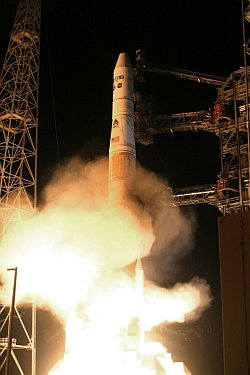
A Delta IV rocket rumbled and roared off launch pad 37B at Cape Canaveral Air Force Station in Florida Thursday evening, sending the GOES-P satellite soaring into a crisp and clear night sky. With liftoff at 23:57 UTC, the rocket could be seen for several minutes after launch, and booster separation was clearly visible to observers on the NASA Causeway. The Geostationary Operational Environmental Satellite-P, or GOES-P, is the latest in a series of meteorological satellites designed to watch for storm development and weather conditions on Earth as well as detect hazards with its emergency beacon support and Search and Rescue Transponder. It will take ten days for the satellite to maneuver to its geostationary equatorial orbit at 35,888 km (22,300 miles). Once there, GOES-P will get a new name: GOES-15.
It will take five months for all the instruments on board to be tested and calibrated. After that, GOES-15 will be a back-up satellite, stored on-orbit and ready for activation should one of the operational GOES satellites degrade or exhaust their fuel.